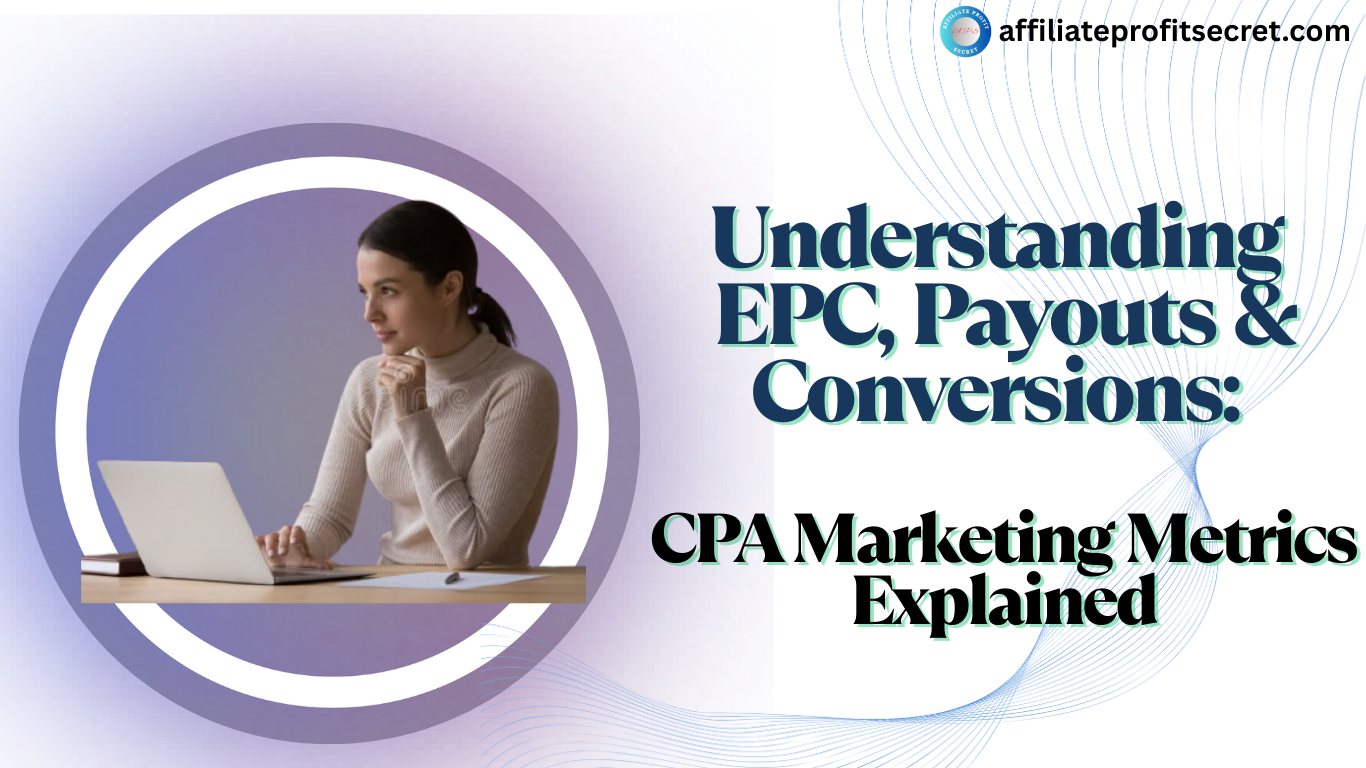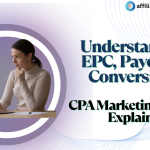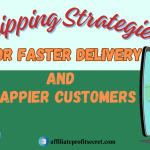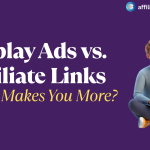Welcome to my article on “Understanding EPC, Payouts & Conversions: CPA Marketing Metrics Explained”. Let’s be real for a second: CPA marketing can feel like decoding the Matrix—except instead of green code, you’re staring at dashboards full of acronyms that sound more like government agencies than money-making tools. EPC, payout, conversion rate… what do they all really mean? And more importantly, how do they help you earn more and waste less? If you’ve ever found yourself running a campaign, checking your stats, and thinking, “Cool… but am I winning or losing?”, this post is for you. These metrics aren’t just for spreadsheet junkies—they’re the GPS of your CPA marketing journey. Without them, you’re basically driving blindfolded… during rush hour… in a car that may or may not be on fire.
In this guide, we’re breaking down the big three of CPA marketing metrics: EPC (Earnings Per Click), payouts, and conversions. We’ll explain what they are, why they matter, how they work together, and how you can use them to find winning offers and scale campaigns like a pro. No fluff, no jargon overload—just clear, actionable info (with a sprinkle of humor to keep your coffee from getting lonely). So buckle up, marketer—we’re about to make these numbers your new best friends.
My Best Recommended & Proven Way to Make $100-$300 Daily – Watch This FREE Video to START >>>

🧮 What Is EPC (Earnings Per Click) & Why It Matters
EPC might sound like some mysterious Wall Street term, but don’t worry—it’s not nearly as complicated as it sounds. In plain English, EPC (Earnings Per Click) tells you how much money you’re making per click on your affiliate or CPA link. That’s it. Simple math, big impact.
Here’s how it works:
Let’s say you earned $100 from an offer after 500 people clicked your link.
The formula looks like this:
$100 ÷ 500 clicks = $0.20 EPC
So every time someone clicked your link, on average, you made 20 cents. Not too shabby, especially if you’re getting thousands of clicks a day.
Now, why should you care about EPC? Because it’s the unofficial scoreboard of how well an offer is performing. Think of it as your campaign’s batting average—if you’re getting lots of clicks but your EPC is trash, you might be swinging at the wrong pitch (or promoting a dud offer). On the flip side, a high EPC means you’ve got a juicy offer that’s converting well and paying out nicely.
Here’s a pro tip: Don’t judge an offer just by the payout. A $100 payout sounds great, sure—but if it takes 10,000 clicks to get one conversion, your EPC is going to be sadder than your coffee budget after a failed campaign. A lower-payout offer that converts consistently could end up making you way more money in the long run.
Bottom line? EPC is your money compass. Track it, test it, and trust it. If your EPC goes up, chances are your bank account will follow. 🤑
💸 CPA Payouts: The Money You Actually Earn
Ah, the payout—the glorious number that makes your eyes light up when browsing offers. It’s the amount a CPA network promises to pay you when someone completes a desired action (like signing up, submitting an email, installing an app, or buying something). In other words, the payout is your reward for getting people to do stuff online. Welcome to performance marketing, where actions speak louder than ad spend.
Let’s break it down: if an offer has a $25 payout, that means every time someone completes the required action (say, a free trial signup), you earn $25. Sounds easy, right? Well… yes and no.
Here’s where it gets tricky: not all high-payout offers are goldmines. Some are just unicorns in disguise—pretty to look at, impossible to catch. A $100 payout might look enticing, but if it converts once every thousand clicks, you’ll be eating instant noodles for the foreseeable future. On the other hand, a $2.50 payout that converts like crazy could quietly rake in serious cash.
My Best Recommended & Proven Way to Make $100-$300 Daily – Watch This FREE Video to START >>>
Also, payouts can vary depending on:
- The type of offer (lead gen vs. sales vs. app install)
- The geo (U.S. traffic usually pays more than, say, Uzbekistan)
- The traffic source (some networks offer higher payouts for email traffic, lower for social)
- The network relationship (veteran affiliates often get bumped-up rates or custom deals)
So while payout is important, it’s only part of the profit puzzle. Pair a decent payout with strong conversions and solid EPC, and that’s where the magic happens.
Long story short? Don’t chase payouts—chase performance. Your wallet will thank you later.
❤️ Conversions: The Heart of Every CPA Campaign
If CPA marketing had a heartbeat, conversions would be it. Everything revolves around that one glorious moment when a visitor stops browsing and actually does the thing—fills out a form, downloads the app, signs up for a trial, or whips out their credit card. That’s a conversion, and in CPA marketing, it’s the one metric that makes the difference between “meh” and cha-ching.
So what exactly counts as a conversion? Well, it depends on the offer.
- Lead gen offer? A completed email opt-in might be the goal.
- App install offer? A download plus opening the app could seal the deal.
- Sale offer? Someone pulling the trigger on a purchase is what counts.
Whatever the action is, your job is to get people to take it. And the percentage of people who do? That’s your conversion rate. Here’s the math:
(Conversions ÷ Clicks) × 100 = Conversion Rate %
So if you get 10 conversions from 100 clicks, you’ve got a 10% conversion rate. That’s solid, by the way—go you.
Why do conversions matter so much? Because without them, you’re just driving traffic to nowhere. You could have a sky-high payout and a nice-looking EPC, but if your offer isn’t converting… you’re just feeding clicks into the void. No conversions = no commissions = no fun.
Want more conversions? It’s not magic—it’s alignment. The offer needs to match your audience, your traffic source needs to be quality, and your landing page should feel more “I trust this” than “I’m about to get scammed.”
Bottom line? Conversions are where all your effort gets rewarded. So test, tweak, and optimize like your paycheck depends on it—because, well, it kinda does.
🔄 How These Metrics Work Together (And What to Watch For)
Alright, you’ve got EPC, payouts, and conversions down—like a boss. But now comes the fun part: understanding how they all work together. Because these metrics don’t live in isolation. They’re like a marketing boy band—each one has its own role, but the real magic happens when they sync up.
Let’s start with the basics:
- Conversions tell you how many people are actually doing the thing (submitting, buying, downloading).
- Payouts tell you how much money you make when they do that thing.
- EPC tells you how well your offer is performing, based on both the conversion rate and the payout.
So what does that mean in the real world? Let’s say you have two offers:
- Offer A pays $80 per conversion but only converts 1 out of every 200 clicks.
- Offer B pays just $10, but converts 1 out of every 10 clicks.
Crunch the numbers:
- Offer A’s EPC = $80 ÷ 200 = $0.40
- Offer B’s EPC = $10 ÷ 10 = $1.00
Boom—Offer B actually earns you more per click, even with a lower payout. See why chasing the biggest dollar sign isn’t always the smartest move?
My Best Recommended & Proven Way to Make $100-$300 Daily – Watch This FREE Video to START >>>
What to watch for:
- A high payout with a super low conversion rate = flashy, but risky.
- A high EPC with solid conversions = likely a winner.
- A “meh” EPC on a popular offer = maybe your traffic isn’t a good match (or maybe it’s time for some landing page TLC).
Treat these metrics like ingredients in a recipe. Alone, they tell you something. Together, they tell you everything. The goal? Find the right balance so your campaigns aren’t just running—they’re printing money. 🖨💸
🛠 Tools to Track & Analyze Your CPA Metrics Like a Pro
If you’re trying to run CPA campaigns without tracking tools, you might as well be throwing darts in the dark—while blindfolded—and spinning. Not ideal. Successful marketers don’t guess what’s working… they know. And that’s where tracking tools come in. These handy platforms show you exactly what’s converting, what’s wasting your budget, and where your EPC is thriving (or crying).
Let’s talk about a few heavy hitters in the tracking game:
🔍 Voluum
A fan favorite among performance marketers. Voluum helps you track clicks, conversions, EPC, geo, device, ad creative… basically everything but your sleep schedule. It’s sleek, powerful, and has automations that’ll make your campaigns smarter than ever.
🧭 ClickMagick
Perfect for affiliates who want something powerful but beginner-friendly. You can track links, run split tests, and even see which traffic sources are actually making you money (spoiler: it’s not always the one you think).
🚀 RedTrack & BeMob
These two are great for scaling. They’re built for high-volume campaigns and integrate with pretty much every traffic source out there. RedTrack even lets you manage your affiliate and media buying all in one dashboard. Multitasking magic.
📊 Google Analytics + UTM Parameters
Old but gold. If you’re not ready to dive into paid trackers just yet, setting up solid UTM tags and reading your data in GA can still give you valuable insights. Just know that it’s not as tailored for CPA-specific needs.
Pro Tip:
Whichever tool you use, set up conversion tracking from day one. Don’t wait until you’ve spent $300 and have no clue where your conversions came from. That’s like baking a cake, forgetting to turn on the oven, and wondering why it’s still gooey.
Tracking = clarity. And clarity = profit. So get nerdy with your numbers—future you (and your bank account) will be very grateful.
✅ Conclusion: Use Metrics to Guide Your Profits (Not Just Your Guesswork)
At the end of the day, CPA marketing isn’t just about launching campaigns and hoping for the best—it’s about making informed, data-driven decisions that actually move the profit needle. And those decisions? They start with metrics. EPC, payouts, and conversions aren’t just numbers on a screen—they’re your campaign’s way of talking to you. The question is: are you listening?
Think of it like this:
- EPC tells you how efficient your funnel is.
- Payout shows you the potential reward.
- Conversions reveal what’s working (and what’s not).
Individually, they’re useful. Together, they’re a powerhouse. Ignore them, and you’ll waste time, traffic, and ad spend. Master them, and you’ll scale faster, smarter, and with fewer “what the heck just happened?” moments.
My Best Recommended & Proven Way to Make $100-$300 Daily – Watch This FREE Video to START >>>
So the next time you’re tempted to chase an offer just because the payout looks sexy, remember to check its EPC and conversion rate first. Let the data do the talking—not your gut, and definitely not that overhyped affiliate forum thread from 2021.
In short? Stop guessing. Start tracking. Because in CPA marketing, the money doesn’t just follow the clicks—it follows the metrics-savvy marketers who know how to read the map. Now go out there, crunch some numbers, and turn those stats into stacks. 💸
Thanks a lot for reading my article on “Understanding EPC, Payouts & Conversions: CPA Marketing Metrics Explained″ till the end. Hope you’ve helped. See you with another article.










